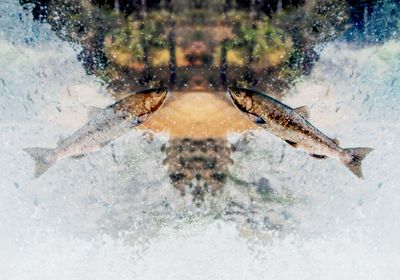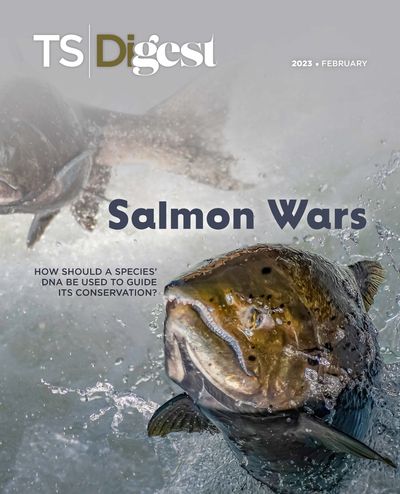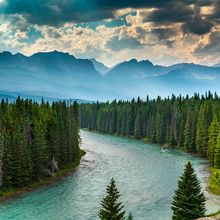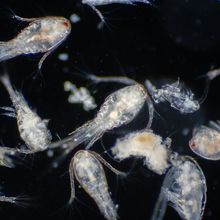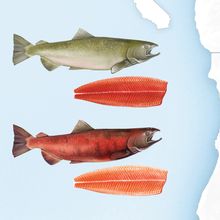ABOVE: © istock.com, Supercaliphotolistic
To the Karuk Tribe, Ishi Pishi Falls on California’s Klamath River is the center of the world. Every spring, a nearby holy site is the location of the first of a set of ceremonies collectively called pikyávish, meaning “fix the world” in the local language, explains Ron Reed, a dip net fisherman and tribal cultural leader who conducted the ceremony for years before passing the mantle on to his sons. Pikyávish includes prayers for the area’s living things and is performed to help keep the world balanced, according to Reed. He says that the Karuk believe humans were put on the planet to be nature’s stewards, and it’s only through that stewardship that people can survive and flourish. “We always like to say the health of the river runs parallel to the health of the people of that river.”
Reed also refers to the annual tradition as the spring salmon ceremony. The timing of the ritual is supposed to line up with the arrival of áama, the first salmon entering the Klamath to return to the waters of their birth, where they will spawn come autumn. Part of the ritual calls to the animals to return, and tribe members don’t start fishing for salmon at Ishi Pishi Falls until the ceremony is complete—a delay that traditionally allowed some salmon to make it past the falls and up into the headwaters of the Klamath before harvesting began. In that way, the ceremony acted as a form of fisheries management, fulfilling the charge of “fixing the world,” says Reed.
But salmon no longer leap up Ishi Pishi each spring—or not many of them. Reed was born in 1962, around the same time that the Iron Gate Dam, which was completed in 1964, cut those early salmon off from hundreds of miles of their ancestral habitat. It was the last straw for fish already dealing with three other dams, habitat degradation from the logging and mining industries, and commercial fishing. Soon enough, spring salmon runs went from countless fish—so many that one could walk across the river on their backs, according to the stories Reed’s mother told him as a child—to almost none. By the late 1990s, Reed says, there simply weren’t springtime salmon to catch for the Karuk pikyávish rituals, and he had to ask a friend from another tribe to obtain the salmon used ceremonially.
We always like to say the health of the river runs parallel to the health of the people of that river.
—Ron Reed, Karuk dip net fisherman
The lack of fresh-caught ceremonial salmon was deeply upsetting. “Everything we do has connection to salmon, to áama,” he says. Traditions are similar for the Confederated Tribes of Grand Ronde, who call the watershed of the Columbia River in Oregon their home. “Our subsistence, our survival has historically been really tied to the health of these runs,” says Sara Thompson, a ceremonial fisher with the Confederated Tribes of Grand Ronde. “Salmon takes care of us. And in return, we take care of salmon.”
It’s not just people who are feeling the salmon’s loss. The nutrients the fish carry in their fatty tissues as they swim upriver to spawn feed all levels of coastal food webs. Bears and other top predators can obtain as much as 94 percent of their annual protein intake from salmon alone, while plants on the river banks get up to two-thirds of their annual nitrogen intake from the fish’s decomposing remains after they spawn and die in the fall.
Many stakeholders, from tribe members to state and federal officials, are hoping to reverse the salmon’s decline. And some say they have a way to do it: by getting federal agencies to recognize the salmon that return to their natal streams to spawn in spring as separate populations from those that make their “run” in the fall. These early-running “springers” go farther inland and spend more time in freshwater than their later-arriving counterparts and are thus disproportionately harmed by habitat degradation. Historically, too, they’ve suffered more from commercial fisheries because their meat is prized.
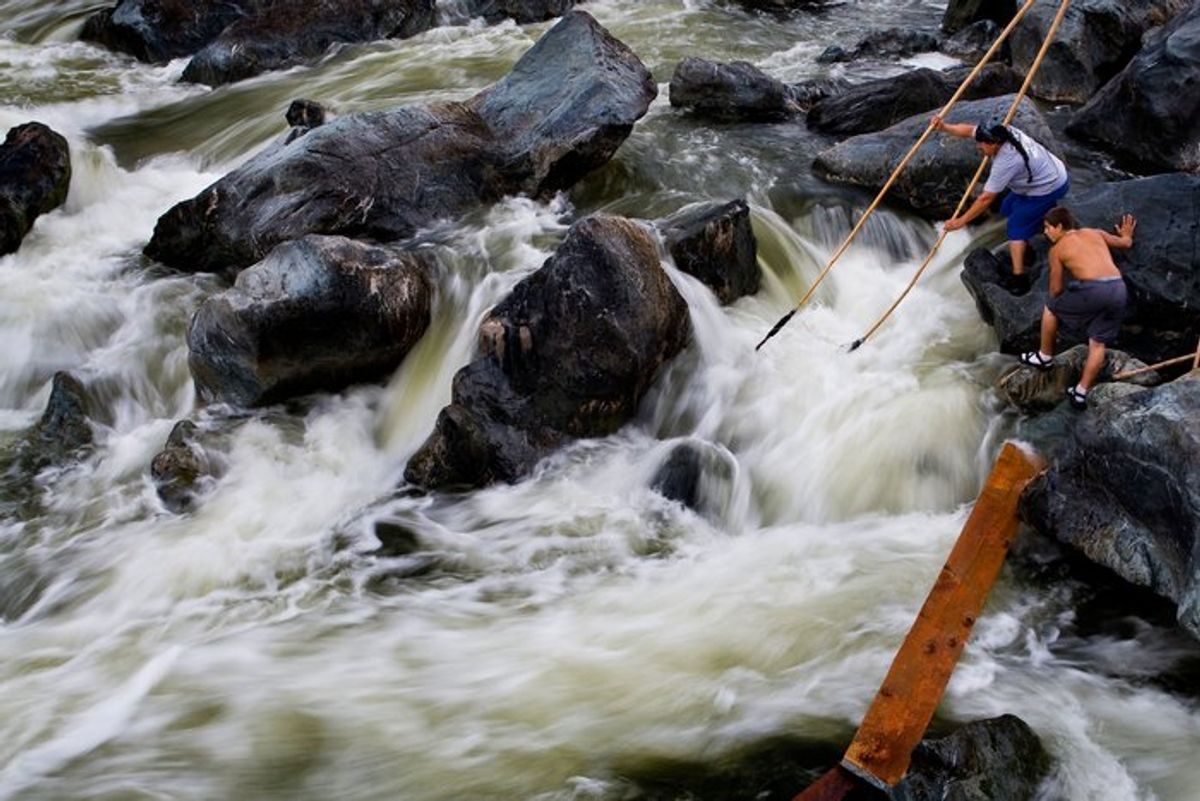
Unlike Chinook salmon as a whole, a group containing only spring-run salmon would clearly exhibit declines that would justify protection under the US Endangered Species Act (ESA), potentially opening up the funding needed to help them, some experts claim. But researchers disagree about the scientific justification for such a separation. The ESA allows subspecies distinctions if it can be shown that there is more than one evolutionarily significant unit (ESU) of Chinook—that is, more than one population that differs substantially at the genetic level. Several geographically separated Chinook ESUs have already been recognized under this rule, but whether spring and fall runs within those groupings meet the requirements is in dispute.
The debate is once again coming to a head as the National Oceanic and Atmospheric Administration (NOAA) evaluates the latest in a string of petitions from local conservation organizations aiming to get spring runs federally protected. NOAA has rejected proposals to split the runs into separate ESUs before, so petitioners are now arguing that the agency must acknowledge that the two represent distinct “life history variants,” both of which are necessary for the health of populations, and therefore protect ESUs with struggling springer populations even while fall-run numbers remain stable. This claim, like the one that the groups are biologically distinct, stems from a suite of recent genetic data that have raised fundamental questions about how such data can or should inform the management and conservation of species.
Pinpointing the genetic differences underlying migration time
Of the seven species of Pacific salmon, Chinook (Oncorhynchus tshawytscha), also known as king salmon, are the biggest. Catches today average around 20 pounds, roughly double the average size of the next largest species, the chum salmon (O. keta). The Chinook was once found from southern California to the northwest coast of Alaska—the largest range of any Pacific salmon—which, along with its size, made the animal integral to the diets and cultural practices of the Pacific Northwest’s Indigenous peoples.
Among Chinook, springers hold special significance in tribal traditions, even having their own word in Karuk—ishyâat. Although they spawn in the fall like their fall-run counterparts, springers can reach spawning habitats as far inland as Idaho before the summer brings dangerously warm waters and natural barriers. Their early timing gives them access to exclusive habitats and a slight head start on the spawning season. And by traveling upriver when they do, they provide a much-needed springtime burst of nutrition after cold, lean months—both for riparian ecosystems and for the people that inhabit them.
Springers look different, too, Reed notes. One can tell a springer fillet from that of a fall salmon by the redness of the meat, which is also distinctively rich because the fish rely on stored energy reserves to survive through the summer without eating until the fall spawning season arrives. Fisheries managers and scientists have also noted physical and behavioral differences between the runs, enough that they’ve long been considered “different populations or stocks,” says Robin Waples, a fisheries biologist who retired from NOAA Fisheries in late 2022.
Despite the apparent differences, genetic work around the turn of the 21st century using allozymes, microsatellites, and single-nucleotide polymorphisms (SNPs) failed to find evidence that notable variation in traits like fat content were hardwired in the animals’ genomes. Springers were essentially indistinguishable from fall-run fish from the same river, Waples explains. Most genetic differences instead occurred between watersheds, a sign that the animals were adapting to their specific environments. Such results also suggested that migration timing likely involved many genes and that differences may have arisen separately in each basin.
When the spring-run phenotype disappears, the allele disappears along with it.
—Mike Miller, University of California, Davis
This evidence led Waples and most other salmon experts to conclude that migration timing was easily evolvable on conservation timescales—a conclusion that shaped policy, as it was assumed that conserving and restoring habitat would eventually lead to the re-evolution of springers from fall runs. But that paradigm was upended when a 2017 paper by University of California, Davis, fish geneticist Michael Miller, his then–graduate student Dan Prince, and others laid out the case that just one snippet of the genome—the GREB1L/ROCK1 genomic region (named for the two genes within it)—dictates migration timing.
The GREB1L/ROCK1 finding was soon confirmed by follow-up work by other teams, and a similar region was found in the genome of steelhead (Oncorhynchus mykiss), a related fish that similarly comes in early- and late-migrating forms (so-called summer and winter steelhead). In Chinook, this region is roughly 140 kilobases long—less than 0.01 percent of the fish’s 2.4 gigabase genome. It remains unclear what specific mutations separate spring and fall timing, though researchers have noted a pair of amino acid–altering SNPs in a coding region of GREB1L. There’s also a 10-kilobase duplication of noncoding DNA flanking the region, which could be involved in regulating the expression of either of its genes, Miller says.
The lack of a clear mechanism for the timing difference has made it tricky to find a marker for genotyping, and is an oft-discussed challenge in interpreting the research to date. SNP resolution in early studies was low, so they didn’t yield clear marker choices for classifying fish as possessing spring, fall, or hybrid genotypes. Various researchers have instead made different choices about which SNPs or combinations of SNPs to use, methodological differences that hindered the ability to synthesize information or answer questions about heterozygosity and gene flow between fall and spring runs, Waples says.
Several researchers have nevertheless taken on these questions. Tasha Thompson, a research fellow with the Wild Salmon Center in Oregon who worked in Miller’s lab as a part of her dissertation (and has since married him), found a few years ago that individuals that are heterozygous at the GREB1L/ROCK1 region migrate in between the spring and fall runs, creating a summer run. Exactly how common this kind of hybridization was in the past is up for debate, but summer runs have been common recently. For the Karuk, the summer run became the tribe’s primary source of Chinook in the 1980s after the collapse of the spring run—until it, too, collapsed.
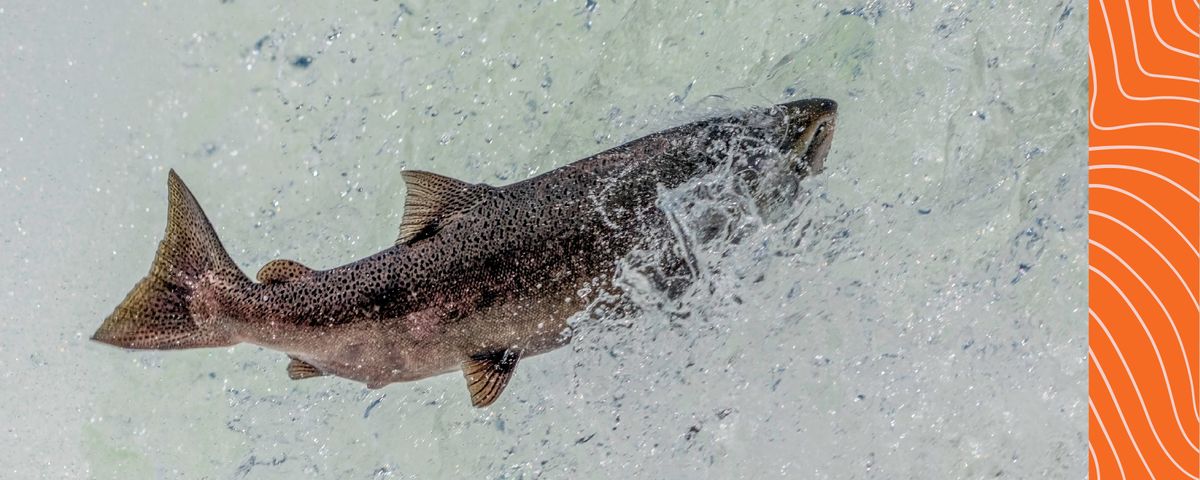
Thompson speculates that hybridization might have contributed to springers’ decline because natural selection may act against spring-fall hybrids—thereby eliminating spring alleles from the population. “Heterozygotes are migrating up at what is the worst possible time from a temperature and flow perspective,” she notes.
Her speculation has support from real-world data: When her team genotyped salmon from archaeological sites on the Klamath, they found that before the construction of the dams, spring-run alleles were so common in the river’s population of Chinook that some villages’ catches consisted entirely of homozygous springers. Now, not only are there no springers, there are barely any spring-fall heterozygotes: Among 437 juveniles pulled from the Shasta River, a major tributary of the Klamath that last saw a spring run of Chinook in the 1930s, the researchers only found two heterozygous fish, suggesting that less than 1 percent of Chinook in the river now carry spring alleles.
Even without selection against heterozygotes, computational modeling by Thompson and her team suggests that strong selection against the spring phenotype can lead to the rapid loss of spring-run alleles over short timescales. Such selection pressure is made more likely by anthropogenic activity, as logging, dam construction, and other human activity that can disrupt the clean, cold water that springers need while they wait to spawn. When the team extrapolated from existing data into the future, they found that the spring-run allele is likely to be wiped out by 2100. Separate research from Miller’s team came to a similar conclusion. As he puts it, “when the spring-run phenotype disappears, the allele disappears along with it.”
Biologist Toz Soto, manager of the Karuk fisheries program (though not a tribe member himself), says the genetic findings help confirm what the Karuk have said all along—that ishyâat are distinct from other áama. Now, he and the Karuk are working with scientists, combining Indigenous ecological knowledge with cutting-edge research methods to fully understand the animals’ biology and ecology. “Karuk people have been here for thousands of years, seeing what’s changed, and talking about it, and managing for that,” he says. “That, to me, is a very, very, very powerful understanding.”
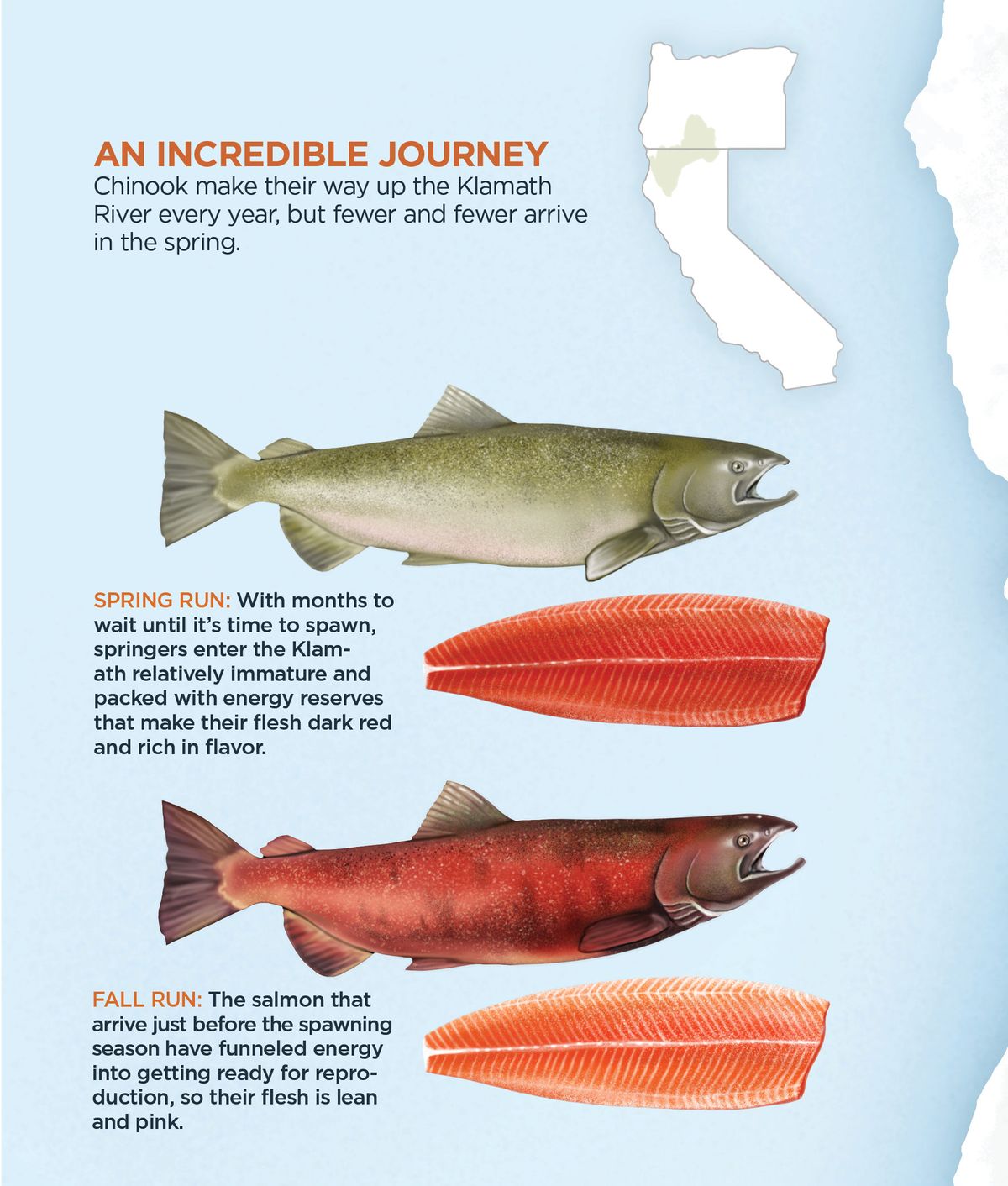
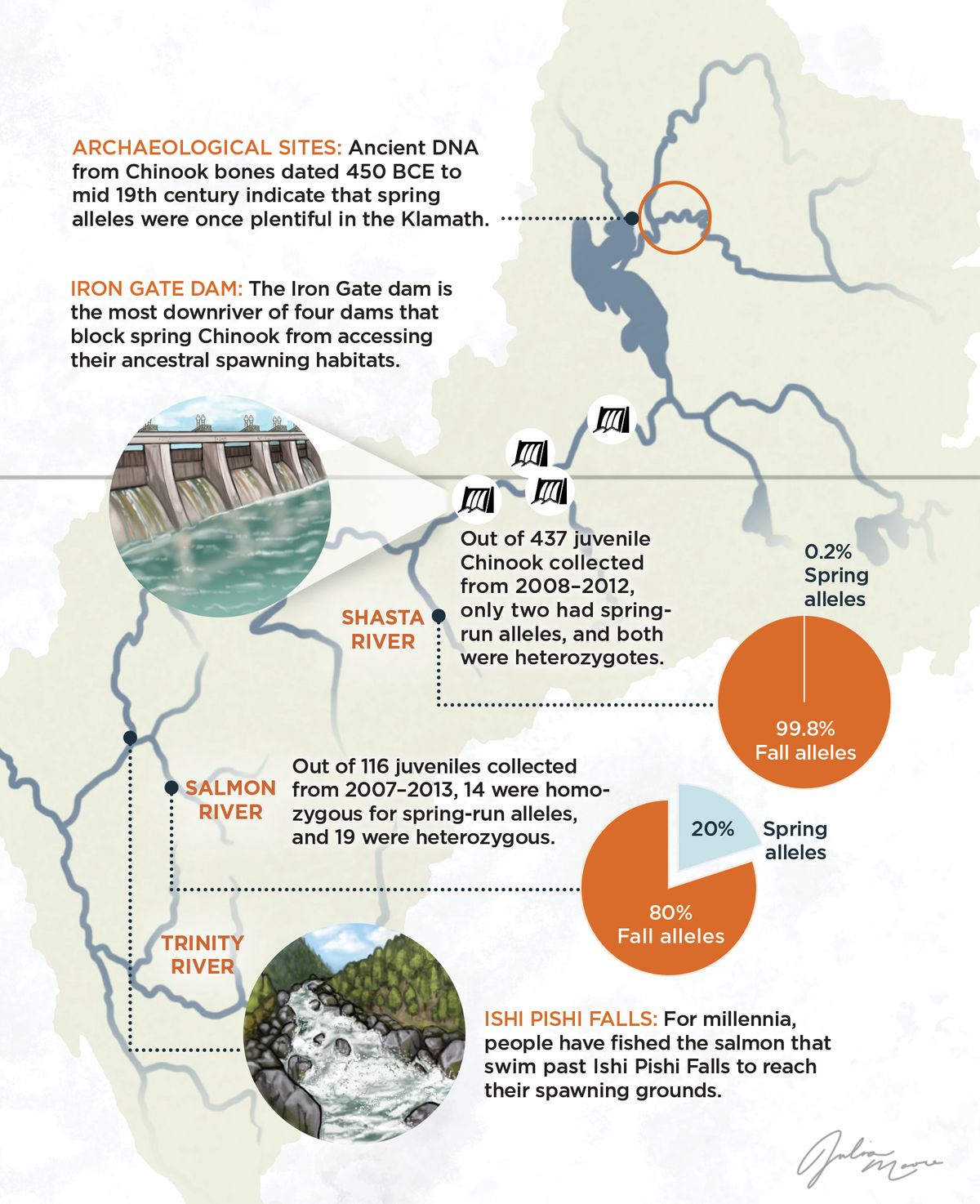
From genes to conservation
Salmon are a hot-button issue in the Pacific Northwest, and clashes regarding scientific findings and conservation policy are common. So it’s perhaps unsurprising that while researchers tell The Scientist that the GREB1L/ROCK1 finding itself wasn’t disputed, there has been substantial disagreement about how it should be interpreted.
In their 2017 paper describing the gene region, Prince, Miller, Thompson, and their coauthors argued that the results “demonstrate that [conservation units] reflecting overall genetic differentiation can fail to protect evolutionarily significant variation” and “suggest that a supplemental framework for protecting specific adaptive variation will sometimes be necessary to prevent the loss of significant biodiversity and ecosystem services.” In other words, the GREB1L/ROCK1 finding supports splitting fall and spring runs into separate conservation units, Thompson says.
But this view wasn’t shared by all of the team’s collaborators, several of whom pulled their authorships between the preprint and final publication. One of those collaborators, University of California, Santa Cruz geneticist and NOAA Fisheries scientist John Carlos Garza, says that the issue was with the conservation policy inferences that Prince, Miller, and Thompson extrapolated from the discovery, a view he expanded on in a comment on the 2016 preprint.
Disagreement centers on how much genetic differentiation between the populations is enough and on how to balance this differentiation against the practical implications of separating Chinook salmon into two. For example, one of the concerns with listing springers separately is that creating ESUs on the basis of a tiny genetic region could prompt a flood of similar petitions for all kinds of species. Other species with loci that have large adaptive effects—such as snowshoe hares (Lepus americanus), some of which still change to white winter coats while others now keep their brown coat year-round—aren’t currently considered different populations, even though their differences are genetically based. Similar large-effect loci dictate migratory behavior in steelhead, beak size in Darwin’s finches, and burrow complexity in Peromyscus mice. And if researchers were to split every ESU based on such genetic discoveries, it could make conservation management more burdensome and expensive, critics argue. (Miller contests this idea, saying that salmon and steelhead are special cases.)
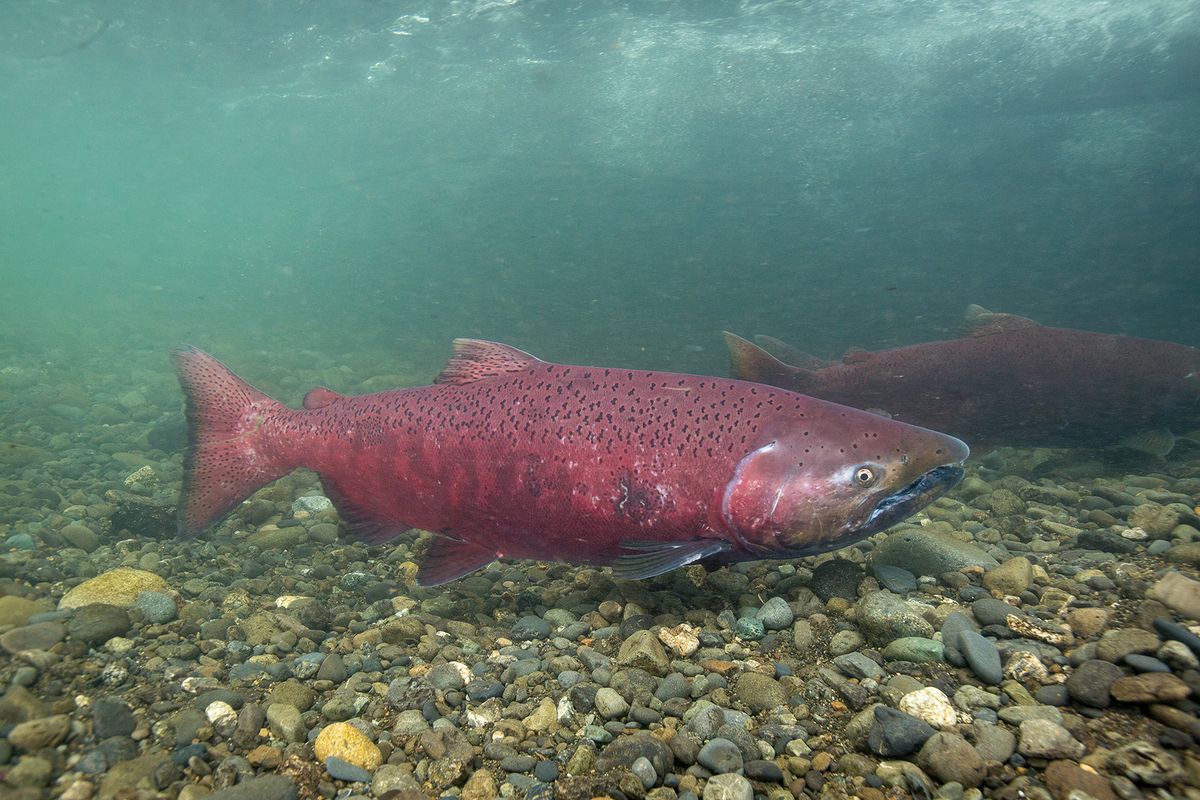
In an email to The Scientist, Garza likens the difference between the spring- and fall-run alleles to human variations in eye color, noting that even siblings can have dramatically different phenotypes. Indeed, in a press release for his lab’s 2020 paper on Chinook genetics, he said: “It’s hard to come up with any scenario where you could classify individuals from the same nest as belonging to different populations.” Waples similarly notes that separating runs into separate ESUs would go against the mandate in the ESA regarding defining conservation by evolutionary lineages, as one would end up with fish in one ESU that are more closely related to individuals in another ESU than to some members of their own.
A November 2021 PNAS paper by NOAA Fisheries scientist Marty Kardos and colleagues articulates another key objection to using large-effect loci for determining conservation units: that focusing on adaptive alleles is missing the forest for the trees. Or, as they put it in the paper, “placing conservation priority on a small, apparently adaptive portion of the genome ignores what may be the vast majority of variation elsewhere in the genome that will fuel adaptation to unpredictable future conditions.”
According to Waples, a 2020 meeting of salmon fisheries scientists established a loose consensus in the field that ESUs should not be split by run timing. However, the group also generally agreed that the GREB1L/ROCK1 findings affect the perceived risk of extinction for Chinook, and especially for spring runs, as they indicate that early migration is not, after all, a trait that can easily evolve in a matter of decades. Because both fall and spring runs are considered essential for the species’ evolutionary health, some parties could now argue that springers and fall-run salmon should be listed together under the ESA, Waples says—counter to a 2021 decision by NOAA, which in refusing petitions to list the coastal spring Chinook in Oregon and California, also declined to list the ESUs as they are.
In fact, NOAA is considering a joint listing of spring and fall runs together, following a petition by the Oregon-based Native Fish Society and collaborators. But a combined ESA listing faces protests of its own. Liz Perkin, the society’s Northern Oregon regional coordinator, concedes that joint listing could affect local fisheries for fall Chinook, which are a big part of coastal economies, by complicating fisheries management and potentially imposing greater restrictions on take. “If you list the entire ESU now, you get a lot of people riled up, because then a lot of different livelihoods are going to be affected by the fact that fall Chinook are also under that.”
And Miller says he worries that a combined listing could mean additional red tape, particularly when it comes to actions that benefit springers at the expense of their later-migrating kin. He points to the Klamath dam removals, for instance: While the removals are necessary for the conservation of springers, they could—at least temporarily—harm fall runs, as the process will affect water quality in the fall Chinook’s spawning habitat downstream. Any such actions that help springers but harm fall fish would be hard to push for if the latter were also considered endangered. “I think a listing of both could prevent a lot of the actions that need to be taken to save the spring run,” he says.
Waples admits that the ESA is a “blunt instrument,” and that listing the ESUs could have drawbacks like the ones Miller describes, especially if the animals are ultimately deemed to be at imminent risk of extinction—as the spring runs arguably are. “That’s the way ESA works,” he says, adding that federal protections ideally work in concert with legislation designed for finer-scale action, such as state-level listings. Indeed, in June 2021, the California Fish and Game Commission ruled in favor of adding the Upper Klamath Trinity Spring Chinook to the California Endangered Species List in response to a petition from the Karuk filed in 2018 based on the Prince et al. paper.
Overall, the plight of salmon highlights a weakness of sorts in the ESA, Waples says, as it considers each listed ESU as if it were essentially a separate species. If listed, each population of spring salmon would therefore have to be managed as if the others didn’t exist—efforts to aid the flow of spring alleles from California to Oregon Coast populations, for instance, would cause “all sorts of potential legal problems under the ESA,” he says. “The most relevant result of the new genomics data for salmon is that it should cause us to rethink and think on a broader scale about conservation of those phenotypes. . . . And I don’t think that can be done just by focusing on one ESU at a time, but that’s not simple under the legal-regulatory framework we have.”
Any ruling on ESA listing could be years away. After all, NOAA has yet to hand down a final decision regarding a petition filed in 2017 for Chinook in the Upper Klamath-Trinity Rivers ESU, though its 90-day finding in that case was that “the petition presents substantial scientific information indicating the petitioned actions”—including possible recognition of the spring run as a distinct ESU—“may be warranted.”
Whatever the decision, Reed says that what the Karuk really want is the ability to manage the fish themselves, as they and the region’s other tribes did for centuries. Instead, while scientists debate the finer details of conservation genetics, the fish continue to disappear—and with them, the cultures and livelihoods of the Pacific Northwest’s Indigenous peoples. “I want people to understand that healthy salmon populations represent more than just that,” says ceremonial fisher Sara Thompson, who, along with other members of the Confederated Tribes, has been pushing local and state governments to let them reclaim their ancestral fishing rights and practices. “Healthy salmon populations represent a healthy system; they represent cultural ties that we maintain that have been passed down through the generations and that we plan to pass down through the generations. And I don’t think you can have a conversation about salmon without having the entire conversation.”
Whatever happens needs to happen soon, she adds, because the alternative is devastating. “The loss of spring Chinook would be a tragedy like none other.”
An Extended BattleChinook genetic data generated in the first decade and a half of the 21st century revealed notable differences between the populations in different watersheds—but not between spring and fall runs within a watershed. Thus, the available evidence supported the geographically based Evolutionary Significant Unit (ESU) designations that were formalized in March of 1998. Still, given known biological and ecological differences between early- and late-migrating salmon, a petition was filed in 2011 asking NOAA Fisheries to split the spring run of the Upper Klamath and Trinity Rivers ESU into a separate unit or population segment, and to list that segment under the Endangered Species Act (ESA). That petition was denied the next year, though some scientists are still of the opinion that spring runs should have special protection. In August 2017, a Science Advances paper from Daniel Prince—then a PhD student in Michael Miller’s lab at University of California, Davis—detailed the genetic basis for migration timing, and these data suggested that the evolution of early-migrating alleles occurred only once millions of years ago instead of recently in each watershed, as scientists had previously believed. In light of these findings, petitions were once again filed, seeking ESA listing for spring Chinook. 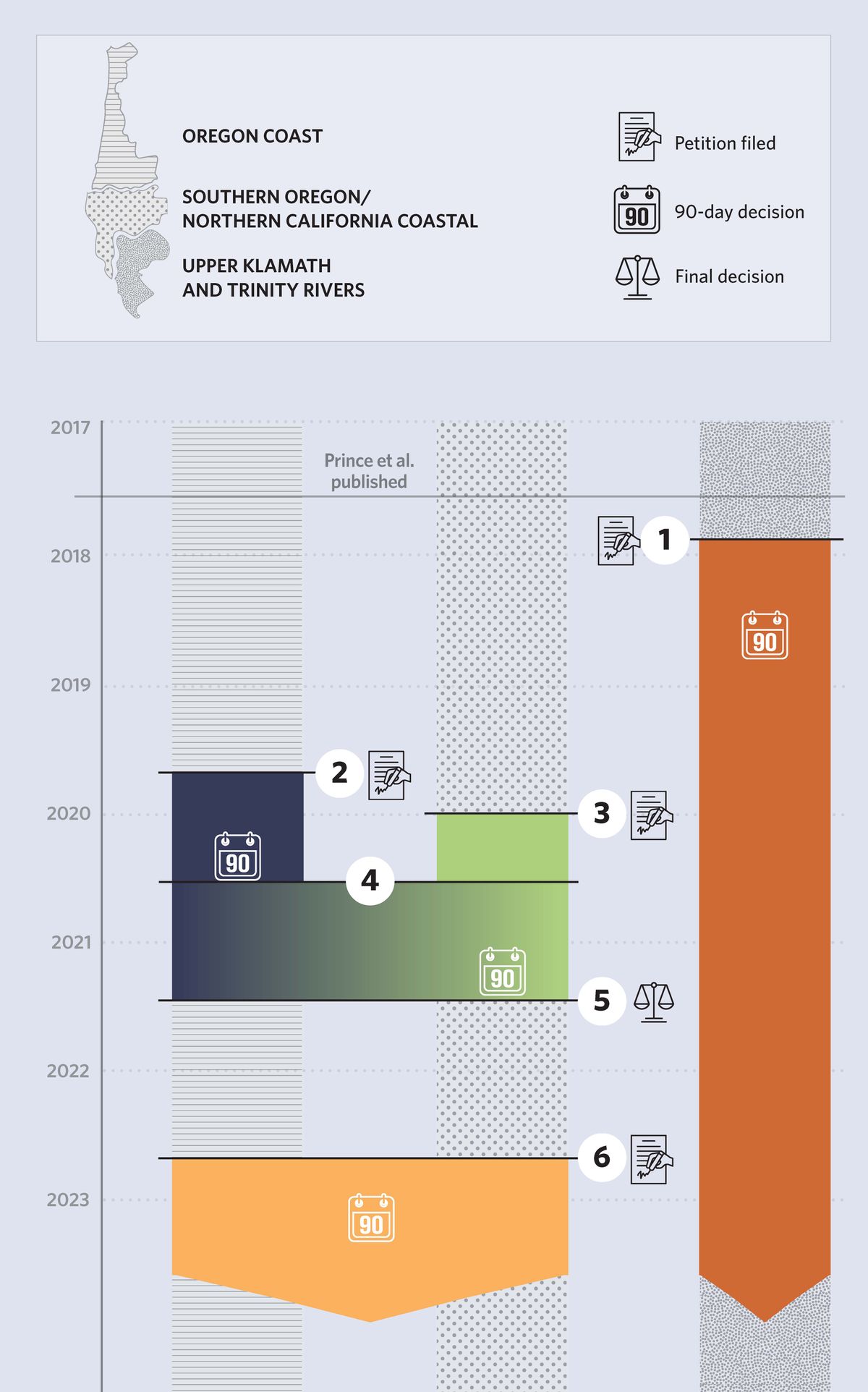 The Scientist Staff | |
 | November 2, 2017: A petition is filed for the Upper Klamath and Trinity Rivers ESU asking NOAA to reconsider separating spring and fall runs and list the spring run under the ESA, contrary to the 2012 decision. On February 27, 2018, NOAA releases their 90-day finding that the petitioned actions may be warranted. As of January 2023, no final decision on the petition has been made. |
 | September 24, 2019: A petition is filed for the Oregon Coast ESU, asking NOAA Fisheries to designate the spring run as a separate ESU and list it under the ESA. On April 13, 2020, NOAA’s 90-day finding is that the petitioned actions may be warranted. |
 | April 15, 2020: A petition is filed for the Southern Oregon Northern California Coastal ESU, asking NOAA Fisheries to designate the spring run as a separate ESU and list it under the ESA. NOAA’s 90-day finding, which was delayed until March of 2021, is that the petitioned actions may be warranted. |
 | May 14, 2020: The review panel for the Oregon Coast petition is asked to consider the Southern Oregon and Northern California Coastal Chinook petition alongside the one it’s already reviewing. |
 | May 25, 2021: The review panel decides that splitting the ESUs by migration timing is not warranted and, therefore, no changes are made to ESA listing status for either ESU. |
 | Aug 4, 2022: A petition filed for both the Oregon Coast and Southern Oregon and Northern California Coastal ESUs. Petitioners ask NOAA to consider listing both ESUs, saying that the genetic evidence is clear: Spring runs represent a distinct and essential life history variant, and therefore, the ESUs are in need of protection regardless of the status of fall runs. Alternatively, the spring and fall runs could be split and just the spring runs listed. On January 11, 2023, NOAA’s 90-day decision is that splitting the ESUs by migration timing is not warranted, but listing them as-is may be. The agency is soliciting comments until March 13, 2023. |
Correction (February 1): The article has been corrected to note that Ishi Pishi Falls is where spring salmon are caught but not the the location of pikyávish. The Scientist regrets the error.
Membership Open House!
Enjoy OPEN access to Premium Content for a limited timeInterested in exclusive access to more premium content?

